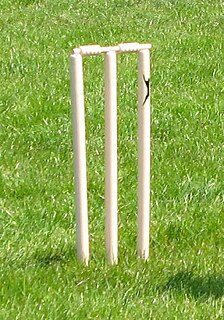
In baseball, an at bat (AB) or time at bat is a batter's turn batting against a pitcher. An at bat is different from a plate appearance. A batter is credited with a plate appearance regardless of what happens during his turn at bat, but a batter is credited with an at bat only if that plate appearance does not have one of the results enumerated below. While at bats are used to calculate certain statistics, including batting average and slugging percentage, a player can qualify for the season-ending rankings in these categories only if he accumulates 502 plate appearances during the season.

Bar mitzvah is a Jewish coming of age ritual for boys. Bat mitzvah is a Jewish coming of age ritual for girls. The plural is b'nai mitzvah for boys, and b'not mitzvah for girls.

Sir Alan Arthur Bates, was an English actor who came to prominence in the 1960s, when he appeared in films ranging from the popular children's story Whistle Down the Wind to the "kitchen sink" drama A Kind of Loving.

Bates College is a private liberal arts college in Lewiston, Maine. Anchored by the Historic Quad, the campus of Bates totals 813 acres (329 ha) with a small urban campus which includes 33 Victorian Houses as some of the dormitories. It maintains 600 acres (240 ha) of nature preserve known as the "Bates-Morse Mountain" near Campbell Island and a coastal center on Atkins Bay. With an annual enrollment of approximately 1,800 students, it is the smallest college in its athletic conference. As a result of its small student body, Bates retains selective admission rates and little to no transfer percentages. The nominal cost of attendance is considered very high with tuition frequently among the most expensive in the United States.

In cricket, the term wicket has several meanings. Firstly, it is one of the two sets of three stumps and two bails at either end of the pitch. The wicket is guarded by a batsman who, with his bat, attempts to prevent the ball from hitting the wicket.

This is a general glossary of the terminology used in the sport of cricket. Where words in a sentence are also defined elsewhere in this article, they appear in italics. Certain aspects of cricket terminology are explained in more detail in cricket statistics and the naming of fielding positions is explained at fielding (cricket).

Kathleen Doyle Bates is an American actress and director. She is the recipient of numerous accolades, including an Academy Award, three American Comedy Awards, two Emmy Awards, two Golden Globe Awards, an Obie Award, and two Screen Actors Guild Awards.

In cricket, batting is the act or skill of hitting the ball with a bat to score runs or prevent the loss of one's wicket. Any player who is currently batting is denoted as a batsman, batswoman, or batter, regardless of whether batting is their particular area of expertise. Batsmen have to adapt to various conditions when playing on different cricket pitches, especially in different countries - therefore, as well as having outstanding physical batting skills, top-level batsmen will have lightning reflexes, excellent decision-making and be good strategists.

The Duckworth–Lewis–Stern method (DLS) is a mathematical formulation designed to calculate the target score for the team batting second in a limited overs cricket match interrupted by weather or other circumstances. It is generally accepted to be the most accurate method of setting a target score. The method was devised by two English statisticians, Frank Duckworth and Tony Lewis and was formerly known as the Duckworth–Lewis method (D/L). It was introduced in 1997, and adopted officially by the ICC in 1999. After the retirements of Duckworth and Lewis, Professor Steven Stern became the custodian of the method and it was renamed to its current title in November 2014.

José Alberto Pujols Alcántara is a Dominican-American professional baseball first baseman and designated hitter for the Los Angeles Angels of Major League Baseball (MLB). He previously played 11 seasons for the St. Louis Cardinals, with whom he was a three-time National League (NL) Most Valuable Player (MVP) and nine-time All-Star. He then was a one-time All-Star additionally with the Angels in 2015. A right-handed batter and thrower, Pujols stands 6 feet 3 inches (1.91 m) tall and weighs 235 pounds (107 kg).

The captain of a cricket team, often referred to as the skipper, is the appointed leader, having several additional roles and responsibilities over and above those of the other players. As in other sports, the captain is usually experienced and has good communication skills, and is likely to be one of the most regular members of the team, as the captain often has a say in team selection. Before the game the captains toss for innings. During the match the captain decides the team's batting order, who will bowl each over, and where each fielder will be positioned. While the captain has the final say, decisions are often collaborative. A captain's knowledge of the complexities of cricket strategy and tactics, and shrewdness in the field, may contribute significantly to the team's success.
In cricket, a batter is not out if she or he comes out to bat in an innings and has not been dismissed by the end of an innings. The batter is also not out while his innings is still in progress.

In baseball, the batting average (BA) is defined by the number of hits divided by at bats. It is usually reported to three decimal places and read without the decimal: A player with a batting average of .300 is "batting three-hundred." If necessary to break ties, batting averages could be taken beyond the .001 measurement. In this context, a .001 is considered a "point," such that a .235 batter is 5 points higher than a .230 batter.

Bats are mammals of the order Chiroptera; with their forelimbs adapted as wings, they are the only mammals naturally capable of true and sustained flight. Bats are more manoeuvrable than birds, flying with their very long spread-out digits covered with a thin membrane or patagium. The smallest bat, and arguably the smallest extant mammal, is Kitti's hog-nosed bat, which is 29–34 mm (1.14–1.34 in) in length, 15 cm (5.91 in) across the wings and 2–2.6 g (0.07–0.09 oz) in mass. The largest bats are the flying foxes and the giant golden-crowned flying fox, Acerodon jubatus, which can weigh 1.6 kg (4 lb) and have a wingspan of 1.7 m.
In cricket, a player's batting average is the total number of runs they have scored divided by the number of times they have been out. Since the number of runs a player scores and how often they get out are primarily measures of their own playing ability, and largely independent of their teammates, batting average is a good metric for an individual player's skill as a batter. The number is also simple to interpret intuitively. If all the batter's innings were completed, this is the average number of runs they score per innings. If they did not complete all their innings, this number is an estimate of the unknown average number of runs they score per innings.

Bates Motel is an American psychological horror drama television series that aired from March 18, 2013 to April 24, 2017. It was developed by Carlton Cuse, Kerry Ehrin, and Anthony Cipriano, and is produced by Universal Television and American Genre for the cable network A&E.
Eumathes cuprascens is a species of beetle in the family Cerambycidae. It was described by Bates in 1874. It is known from Nicaragua and Panama.















